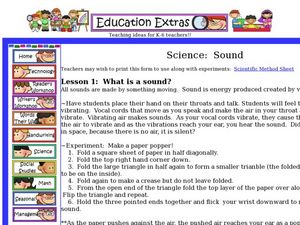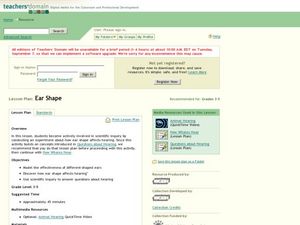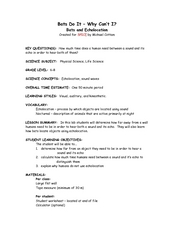Curated OER
What is a Sound?
Second graders explore the concept of sound. For this sound lesson, 2nd graders discover what sound, vibrations, and pitch are through several experiments. Students watch a Power Point presentation that allows them to complete a graphic...
Curated OER
Ears Help Us
In this biology instructional activity, students draw pictures of how ears help us. They illustrate ears being use for communication, relaxation, happiness, and for safety.
Curated OER
Physics of Sound: How We Hear Sounds
Students examine the way they hear sounds. In groups, they label and identify the functions of the different parts of the ear. After reading a book by Helen Keller, they research the mechanisms of sound and how sounds are different...
Rochester Institute of Technology
Artificial Hearing
Your sense of hearing depends upon tiny hairs deep inside your ear and if you lose these hairs, you lose your hearing. Here, groups explore hearing through the decibel measurement of common sounds. As a class, participants discuss...
Green Education Foundation
How Loud is Too Loud?
Ever wonder how loud a sound has to be to cause damage? Young scientists explore sound properties by researching decibel levels. They discuss how sound is perceived by our ears and our brains and why it can cause negative health effects...
Curated OER
Lesson Plan Three: Sense of Hearing and The Ear
Learners use their sense of hearing to observe sounds at school, label parts of the ear, and write their own version of the "Ears Hear" poem by following the example provided.
Curated OER
Sounds Like Science-Guitars
Young scholars demonstrate the relationship between a sound and its frequency. In this sound and frequency lesson, students use an old tennis racket and nylon fishing line to create a guitar. Young scholars observe the pitch and frequency.
Curated OER
Sound: The Vibration of Materials
Students recognize that sound is produced by the vibration of materials. They see that the sound produced is dependent on the type of material that is used. Given four types of material; air, string, wood, and metal, students perform an...
Curated OER
Sound All Around Us
Learners make predictions about how sound is formed. They view and discuss a video that explores sound formation and attempt to identify the origin of different sounds.
Curated OER
Experimenting with Sound
Students explore physical science by completing a worksheet. In this sound perception lesson, students collaborate in small groups to research sound properties on the Internet and in libraries. Students conduct a listening experiment by...
Curated OER
Blast-Off to Blending
Practice working with different phonemes in consonants and vowels. Sounds are written on squares that get put on a rocket to "blast off" and meet other sounds. The teacher first models blending, then reads the new words. Young readers...
Curated OER
Noise and Your Ears: Worth Hearing About
In this science learning exercise, students complete various puzzles demonstrating knowledge of the ear and how it processes sound. An illustration of the ear with descriptions of each part is provided.
Curated OER
Ear Shape
Students explore hearing. In this hearing and sound lesson, students participate in a scientific inquiry to compare ear shape and hearing ability. Students work with a partner to listen to soft music and use various materials to...
Curated OER
Sounds of the Wetlands
Students identify the sounds of different bird calls. In this biology instructional activity, students create a sound map. They explain how this method is important in tracking wildlife.
Discovery Education
It's Too Loud!
STEM scholars investigate sound attenuation by conducting an experiment in which they compare the farthest distance that they can hear a sound with and without ear protection.
Curated OER
Ears and Hearing
Students explore vibrations and sound waves. In this lesson about hearing, students use experiments to determine how sound waves travel. Students use a saucepan, rice, and a plastic cover for one experiment and a tube, plastic wrap, a...
Curated OER
Why Your Ears Pop
In this ears worksheet, students read about what causes your ears to pop when you change altitude and about equalizing air pressure. Then students complete 3 short answer questions.
Curated OER
Sound and Hearing
In this sounds worksheet, students will review how sound is created by vibrations. Students will understand what creates vibrations and how the ear receives those sound waves. This worksheet has 10 fill in the blank, 9 multiple choice, 1...
Curated OER
Sound; Year 1
Young scholars, on a listening walk around the school and its grounds, make notes/comments on the range and variety of sounds in each environment. They listen to recorded sounds and attempt to recognize them.
Curated OER
Echolocation
Students explore echolocation. In this bats science lesson, students compare sunlight reflecting off a mirror to sound waves hitting a bat's ears. Students complete a worksheet about bats.
Curated OER
Applied Science - Built Environment (5) Pre Lab
Fifth graders look at the impact of sound and noise. In this sound lesson, 5th graders review the decibel and common sounds along with their noise levels. They complete a worksheet about the different sounds that one might hear during...
Curated OER
Bats Do It-Why Can't I?
Students explore echos and how they are utilised in navigation. For this sound lesson students calculate the amount of time between a sound and its echo.
Curated OER
Rhythm and Art: Gesture Drawing
Students explore connections between non-verbal language and art. In this visual and auditory art lesson, students investigate the science of sound and principles of drawing. They then use various genres of music to directly apply that...
Curated OER
Sounds Good To Me - Instrument Creation
Third graders differentiate between pitch and volume and explain how sound travels through different materials. They analyze sound waves for their basic characteristics. Students design an instrument based on the principles of sound...

























